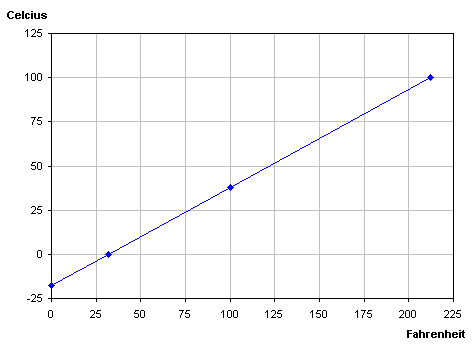Fahrenheit and Celsius temperatures scales were originally based on the freezing and boiling points of water.
On the graph below we can find the freezing and boiling point for water in both systems. The coordinates for these points are (32, 0) for the freezing point and (212,100) for the boiling point. When finding the slope or rate of this line we calculate (y2-y1) / (x2-x1), or the rise over run.
(212-32=180) / (100-0=100)
180 / 100 = 1.8
The slope can be written as the decimal 1.8, or as a fraction, 9/5 (in simplest form).
- Ready to try out your skill at finding patterns in graphs? Go to Math-play.com for interactive games.
It shows that the starting point for Fahrenheit is 32 degrees, the point at which water begins to freeze. So, the number 32 can be added to the product of Celsius times 1.8 to find out the degrees Fahrenheit. This equation fits into the slope intercept form; y= mx + b, F=1.8*C + 32 F= Fahrenheit, C= Celsius.

For example, if the temperature is 25 degrees Celsius, what is the temperature in degrees Fahrenheit?
F=Fahrenheit and C= Celsius F= 1.8 * C + 32
F= 1.8 * 25 + 32
F= 45 +32
F= 77 degrees So, 25 degrees Celsius = 77 degrees Fahrenheit
Another pattern in measurement involves different systems in measuring distance, Miles and Kilometers.
The relationship between miles and kilometers is similar because for every 1 mile we use a slope of .621 kilometers. In an equation we can write k=.621*m (k= # of kilometers, m= # of miles)
If a family traveled in a car 36 kilometers, how many miles did it travel to its destination?
k= Kilometers and m= miles k = .621*m
36 = .621*m
36 /.621 = about 57.97 miles So, 36 kilometers equals about 58 miles.
Since both of these measurement patterns are written in slope-intercept form it is helpful to put them in graphic form, by using an online graphing calculator. The graph below is the equation y=.621* x in graph form. Even though the graph shows negative integers for x and y values, since we are figuring out distance the values that are useful are those that begin at zero and have positive values.
- Practice Game: Use slope intercept form to make an online graph. 1) Create a table of values to solve for x and y. 2) Then, move the graphing position to create a line that matches your data points.

No comments:
Post a Comment